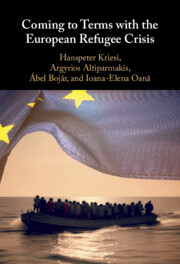Tables
3.1Average rejection rates 2010–14 for asylum seekers from Syria, Afghanistan, Iraq, Pakistan, and Nigeria, and annual budgets for national asylum systems in 2018 (in million euro)
5.1Correlations between politicization and problem/political pressure, by member states
6.1The distribution of broad actor types across the forty domestic refugee crisis episodes (column percentages)
6.2The distribution of broad targeted actor types across the forty domestic refugee crisis episodes (column percentages)
6.4The distribution of dominant conflict lines by types of episodes (frequencies and column percentages)
7.1The distribution of actor types across the six EU-level episodes
7.2The distribution of targeted actor types across six EU-level episodes
7.4Executive decision-making at EU level and policy stage, percentage shares
7.5Conflict intensity scores for the dominant conflict lines, by episode
9.3Frame distributions in speech analysis and PPA: percentages
10.1The impact of problem pressure and political pressure on levels of support behind government policies
10.2Actor-specific models predicting levels of support for government policies
11.1Overview over the four types of cross-level policy interventions
11.2Cross-level politicization of policymaking episodes: OLS-regression coefficient, t values, and significance levels
12.1The distribution of actor types in the EU–Turkey episode, by level and country
12.2The distribution of target actor types in the EU–Turkey episode, by level and country
12.3Executive decision-making in the EU–Turkey agreement by level and country, share of top leaders
12.4Role of actors from different countries by policy stage, percentages
12.5Conflict scores for the dominant conflict lines, by episode
12.6The salience of the different types of actors in the four episodes of phase 1: percentages
12.7The salience of the different types of actors in the three episodes of phase 1: percentages
13.1Transnational polarization by policy and country, Kolmogorov–Smirnov statistic
13.2Immigration attitudes by country (ordered by share against)
13.4Domestic polarization between pro- and anti-immigration groups, by policy and country, Kolmogorov–Smirnov statistic
13.5Comparison of overall polarization, transnationally and domestically by attitudes and party family, across policies: Kolmogorov–Smirnov statistic
14.1Patterns of party family positioning toward the radical right and issue ownership of immigration in the elections after the refugee crisis
14.2Vote changes per party family, comparing the election immediately before and after the refugee crisis



